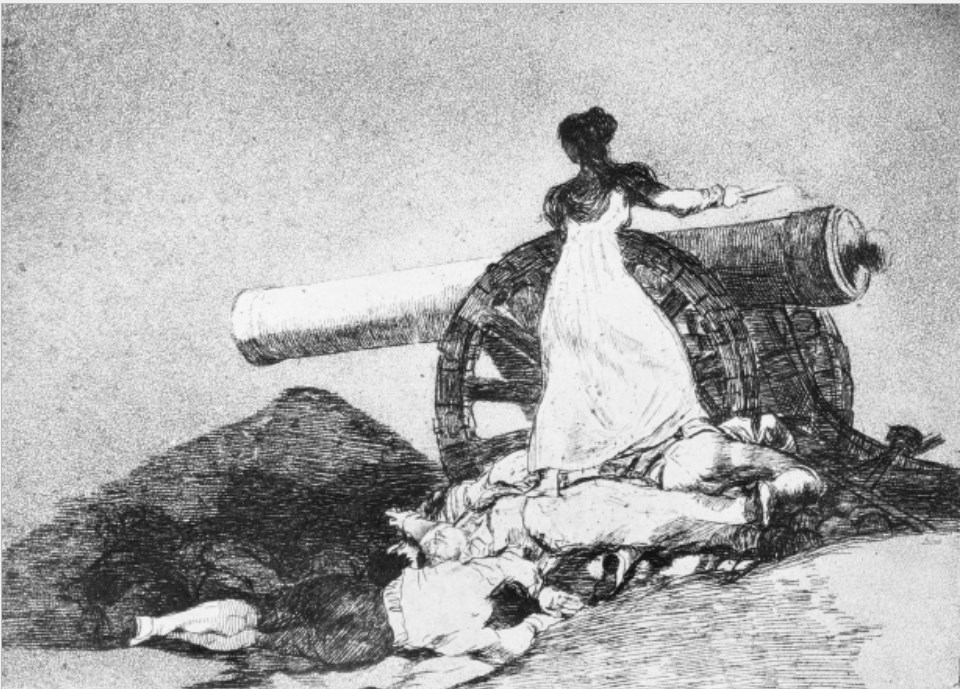
Agustina Domenech’s exploits in the siege of Zaragoza inspired one of
the few heroic etchings in Goya’s series “The Disasters of War.”
Napoleon Bonaparte’s invasion of Spain in February 1808 set
revolutions in motion throughout Latin America. It created a different kind of
popular movement in Spain itself: resistance. For six years, Spanish patriots,
men and women alike, fought against the French occupation in small irregular
bands and provided critical support to the British Army in the Peninsular War
against France. Twenty-two-year-old Agustina Zaragoza Domenech (1786–1857), who
kept a key artillery position from falling into French hands at the first siege
of Zaragoza, became the face of that resistance—so much so that British poet
Lord Byron and Spanish artist Francisco Goya both created works celebrating her
heroism.
Napoleon’s invasion of Spain had its official roots in
long-simmering tensions between King Carlos IV of Spain and his son Ferdinand.
Fearful that his father intended to remove him from the succession, Ferdinand
asked Napoleon to help him depose his father.
If Ferdinand had been patient, the throne would have fallen
into his hands without the risk of inviting Napoleon to invade. Carlos IV and
his wife were not popular with their subjects. In March 1808, a public uprising
forced Carlos to abdicate in favor of Ferdinand. The new king arrived in Madrid
on March 24, one day after French commander Joachim Murat entered the city at
the head of the French army. Dissatisfaction with Carlos IV’s corrupt
government was so strong that many Spaniards greeted the French as liberators.
By the end of April, it was clear the French had come to conquer, not to
liberate.
On May 2, rumors spread that the French planned to forcibly remove
the remaining members of the royal family to Bayonne, where Carlos and
Ferdinand were now held captive, having abdicated in favor of Napoleon’s
brother. Violent protests erupted in Madrid. A cavalry unit made up of the
Muslim slave soldiers known as Mamluks, a souvenir of Napoleon’s invasion of
Egypt, charged the protesting crowd, which was armed with little more than
cudgels and knives. Once the protestors were dispersed, Murat’s men rounded up
everyone they could find who was armed. Executions lasted through the night and
well into the morning.
The brutal repression of the May 2 protest fueled resistance
across Spain.
Agustina Zaragoza Domenech was the wife of Juan Roca, a
Spanish sergeant stationed at Barcelona. With Ferdinand’s abdication, the Spanish
army owed its allegiance to Joseph Bonaparte—and indirectly to France. Plenty
of Spanish soldiers were unhappy with this arrangement, including Roca. Like
many other Spanish soldiers, Roca fled French-occupied Barcelona after the May
uprising in Madrid and made his way to Zaragoza, where General José de Palafox
had organized resistance against the French. Domenech followed her husband
there with their four-year-old son. Soon after reaching Zaragoza, Roca was sent
to join a force some hundred miles away, leaving Domenech on her own in
Zaragoza when the French army besieged the city on June 13.
Palafox held the French off for two months, from June 13
through August 15, with an improvised force of soldiers and townspeople—similar
to those that have defended besieged cities throughout history. Domenech, like
other women in the city, took on the tasks women traditionally performed in a
besieged city: bringing food and water to the men on the city walls and caring
for the wounded.
On July 2, 1808, the French launched a new attack on the
city walls. As Domenech approached an artillery battery near the Portillo gate
on the east wall of the city, a French shell destroyed the battery’s earthwork
defenses and killed or incapacitated most of its gunners before they could fire
their last round. The French army stormed the position. Domenech took a
linstock—a long pole designed to hold a burning length of wicking, known as a
“slow match”—from the hand of one of the fallen soldiers and fired the loaded
twenty-four-pound cannon. Hit by a round of grapeshot at close range, the
French retreated. Domenech received a medal, a small pension, and an honorary
commission as a lieutenant for her bravery.
Domenech was not the only woman to fight at Zaragoza. By all
accounts, many women took part in the city’s defense. At least two others
received official recognition for their services. French horsemen surrounded a
peasant woman named Casta Álvarez (1776–1846) as she delivered food and water
to a key artillery battery. She grabbed a musket and bayonet and joined the
battery’s defense. She received a pension and a medal for her role. Manuela
Sancho (1783–1863) was wounded defending the convent of San Jose during the
second siege. General Palafox, who clearly saw the promotional value of women
warriors, mentioned her with honors. She, too, received a pension for her
services at war’s end.